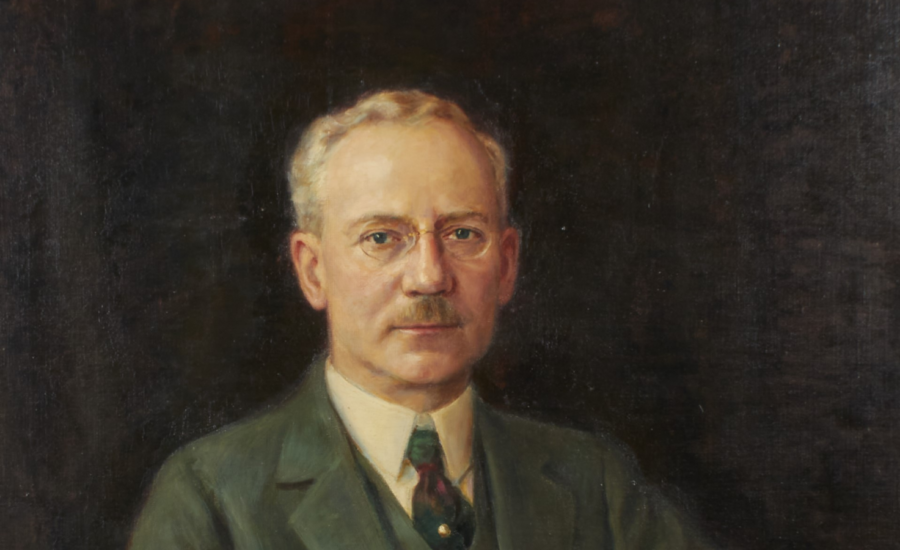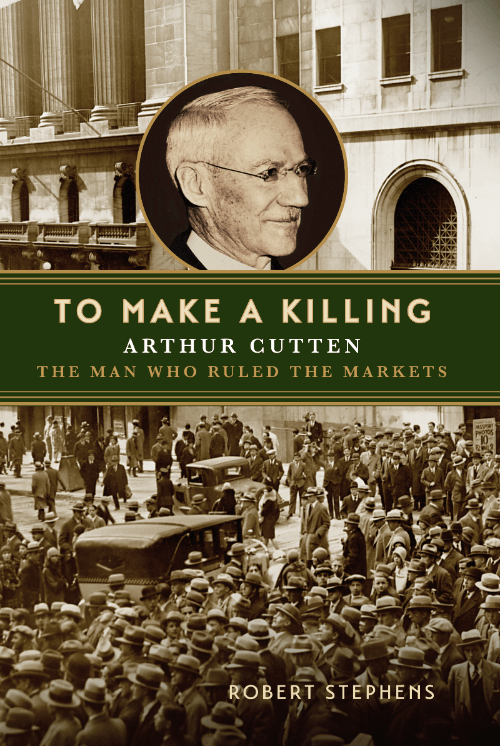The life and times of an original “bankster”
Few people today know of Arthur Cutten, but in the Roaring ’20s, this Canadian stock speculator could move markets. A new biography details his exploits.
Advertisement
Few people today know of Arthur Cutten, but in the Roaring ’20s, this Canadian stock speculator could move markets. A new biography details his exploits.

Growing up in Guelph, Ont., in the 1870s, Arthur Cutten was a whiz with numbers and a shark at marbles, routinely capturing the most coveted orbs (“glassies,” if you’re curious) from his less-skilled classmates. That competitive spirit served him well years later, when 19-year-old Cutten—eager to distance himself from legal troubles his banker father had brought upon the family—set out for Chicago with $90 in his pocket.
It was in the Windy City that Cutten became a highly influential stock and commodities speculator, first revered for his prowess and then loathed for … well, you’ll have to read Robert Stephens’ fascinating new biography to find out. To Make a Killing: Arthur Cutten, the Man Who Ruled the Markets details Cutten’s path to immense wealth and notoriety, starting with his early days working the Chicago Board of Trade’s famous “wheat pit” and ending with all the makings of a true-crime drama: murder, mobsters and (maybe) hidden treasure. We share an excerpt below. —MoneySense Editors

Arthur Cutten took a room in a boarding house at Dearborn and Ontario Streets on the North Side for $6 a week. He found work in a hardware store on Lake Street, earning barely more than his rent. A series of menial jobs followed, each lasting only a few weeks or months. He worked as a stock boy in Marshall Field’s Wholesale Store, where he quickly came to the conclusion that he “was not designed to be a merchant.”
His next stints were as a store salesman at Atwood’s Haberdashery and then as a clerk at Charles H. Besley Company (a machinists’ supply and copper and brass goods business) where he toiled from 7 a.m. to 6 p.m. and was so tired after work that he would just go to bed. He moved on to Hately Brothers, packers and provision exporters, where he stayed for a brief time.
His only form of entertainment was playing baseball on Saturday afternoons. He was a member of the Hyde Parks, which went up against other amateur teams, such as the Idlewilds (made up of Northwestern University students) and Douglaston. To Arthur’s chagrin, some of the clubs started bringing in professional players, which spoiled the competition and led to the breakup of the league.
After more than a year, Arthur was having a pretty dull time of it. But he had learned an important lesson. “I had discovered that the acquisition of capital, much more than luck, was apt to govern the fate of a man trying to advance himself from obscurity.”
Then, in July 1891, he landed a position that would change his life.
It was with A. Stamford White & Co., a stock, bond, and commodities brokerage house that also specialized in buying meats for export to England, France, Germany, and other countries. His boss, whose name the company bore, was a portly, whiskered gentleman and a fixture on the exchange.
Arthur was hired as a bookkeeper and clerk. As part of his job, he was required to go to the exchange floor in the mornings to obtain the opening prices of grains and other commodities. On his first visit, he was awestruck. Men crowded around the trading pits where they bought and sold, using hand signals and barking their orders, closing deals worth hundreds of thousands of dollars without anything written down, a great hubbub of excitement and commotion where fortunes were lost and won. “Neither baseball careers nor bugle calls nor anything else had so much power to stir my mind and emotions,” he exclaimed.
Whenever he could, Cutten hung out in the Pigeon Roost, a small area above the pits, where he could study the action. There on the exchange floor, sitting in a chair tilted back against a pillar, was Jim Patten himself. He was chewing gum, as usual, his big red mustache moving in a wide arc. The Cudahy brothers were circling the provision pit, ready to sell millions of pounds of meat if the price was right. William Bartlett and Frank Frazier, their eyes riveted on wheat prices, conferred with Patten as they plotted their next campaign.
Cutten often ate at Kohlsaat’s restaurant in the old Royal Insurance Building. It was one of the first lunch counters in Chicago where customers sat on stools and were served sandwiches and other quick-service foods, their hats still on their heads, crowded elbow to elbow. On one occasion, he found himself sitting next to Benjamin P. Hutchinson.
“Old Hutch” was famous among the traders and dealers for having once been the shrewdest operator on the Chicago Board of Trade (CBOT). Back in the spring of 1888 he engineered a corner in wheat. He began purchasing futures contracts at around eighty-six cents a bushel. Prices slowly rose through the summer as he bought up the supply. Edwin Pardridge, his old nemesis in the pits, was shorting – selling contracts in the belief that wheat was headed lower and that he would be able to cover his position at depressed prices and make a profit on the difference. And then an early frost swept over the Red River Valley destroying a large part of the crop, and by September wheat was at two dollars. “Old Hutch” made millions.
Cutten had heard the stories about this legendary speculator – how he had started as a shoe and boot manufacturer in Massachusetts, moved to Chicago where he grew wealthy by supplying meat to the Union Army during the Civil War, and established the Chicago Packing and Provision Company as well as the Corn Exchange Bank.
Without a word passing between them, Cutten watched in fascination as this tall, thin man slurped at his soup. Hutchinson was dressed in clothes that had been fashionable at the time of Abraham Lincoln some thirty years earlier. His coat was buttoned at the top, and his doeskin pants did not reach his ankle bones. Beneath the wide brim of a black slouch hat, his fierce eyes and hawk nose gave him the look of a predator. And then “Old Hutch” was gone, like an apparition, disappearing into the afternoon.
With his new job at A.S. White & Co., Cutten was now able to afford slightly better accommodation, sharing a room in a big house. The residence, located near Congress Street and Michigan Avenue, even had electric light. The rent was forty dollars a month.
The young apprentice was learning the intricacies of trading in commodities. One of his first observations about the pits was that the loudest voices were not always the most successful traders. Secrecy was crucial to putting together a big operation. He discovered that those who truly played the grain markets well were serious students of weather patterns, insect infestations, world supply and demand figures, and a host of other factors. He watched the great ones and found that they bought and sold based on the information they had acquired, not on the tips and gossip proffered by others. They cut their losses quickly but allowed their gains to mount.
These were lessons he would apply throughout his career. It was an education that he could have had nowhere else. He was learning from the masters, and Cutten was an astute observer of human nature. He recognized that it was greed and fear that fuelled the markets, and he saw that both the irrational gains driven by dreams of easy money and the terrifying plunges induced by panic were golden opportunities for those few who could control their emotions and trade with the quiet confidence of their convictions.
He revered the big players, they were his heroes and his role models. If you could survive by your wits, if you could outmanoeuvre your opponents and beat them at the game, that was success. There was no room for sympathy. There was only the score.
It took five years, but finally Arthur persuaded his boss that he was ready to work as a full-time broker in the pits. On 11 November 1896, Cutten became a member of the Chicago Board of Trade. A. Stamford White gave him an eight-hundred-dollar loan to cover his membership cost.
He would be buying and selling commodities on behalf of clients, and his starting salary would be $150 a month. As well, the firm would permit him to scalp for himself – make short-term trades on small price movements in corn, wheat, rye, barley, and oats in order to supplement his wages.
Cutten arrived that morning, stopped outside the Board of Trade building, and caught his breath. He looked up at the massive structure, constructed of steel and granite, Chicago’s tallest at the time. Two large statues, one representing Agriculture and the other Industry, stared down from the capstone above the main entrance. He stepped inside and entered the eighty-foot-high great hall that was decorated by a stained-glass skylight and massive marble columns.
He received his first order and nervously walked out onto the exchange floor. He was twenty-six. With his thin mustache, starched shirt, and new trading jacket, he looked like the rookie he was. Veteran traders gave him the once-over and then turned back to their business as though he was of no consequence.
Cutten moved purposely to the corn pit and, in the open-outcry method, shouted out an order to buy one hundred September corn (100,000 bushels for delivery in September). He took twenty-five thousand bushels from each of four men and the order was filled. “I was exalted. This was, for me, a kind of knighthood.” He would add later: “The day I first walked onto the floor of the exchange as a member was a scarlet one for me; and no wonder for it was in the pits that I learned how to make money.”
Cutten learned how to trade on margin (putting up only a portion of the cost to increase his potential returns) and to buy and sell for fractions of a cent. He became skilful in moving from long positions (buying securities with the expectation that they would increase in value) to short positions (borrowing securities and selling them, hoping to buy them back later at a lower price) and back again in minutes. He rarely traded more than ten thousand bushels at a time but made 20 to 30 trades a day. The money was good, but he knew that he was never going to get really rich. Scalping, by its nature, was short term, and he’d never be able to catch the big swings. He wanted more than a comfortable living. He wanted to make a killing.
This article is excerpted from To Make A Killing: Arthur Cutten, the Man Who Ruled the Markets (McGill–Queen’s University Press, February 2024) with permission from the publisher.
Share this article Share on Facebook Share on Twitter Share on Linkedin Share on Reddit Share on Email